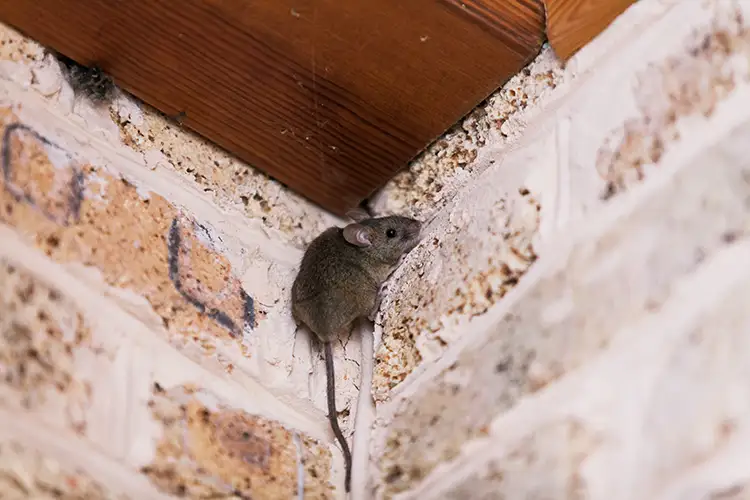
It’s late at night, and the house is quiet. As you settle in for a snack, a sudden movement catches your eye — a tiny figure darts across the floor, quick as a flash. Was that… a mouse in your house? Your mind races with questions. “Do I have a mouse infestation?”
You’ve spotted a mouse in your house – now what? Does the presence of one mouse indicate more are lurking nearby? It often does, but not always. The important thing to understand is that even one mouse is too many, so you need to take action immediately. So, let’s talk about what you need to know and the next steps you should take after spotting a mouse in your house.
If I See One Mouse, Is It an Infestation?
Mice are social creatures. Seeing one mouse could be a sign of a larger issue — a hidden infestation that’s just beginning to show itself. Mice are drawn indoors for food, warmth, and shelter, often bringing their entire family. While it’s possible that the mouse you saw wandered in by itself, it’s more likely that it’s part of a bigger problem, or it may quickly become a bigger problem.
Mice reproduce rapidly. Even a single pair can lead to an infestation in a short amount of time. The safest approach is to assume that this lone mouse is the tip of the iceberg and to take immediate action to prevent a small issue from becoming a much larger one.
What Should You Do If You See a Mouse in Your House?
When you spot a mouse, you should treat the situation with the urgency it deserves. We recommend calling a rodent control specialist ASAP.
Here’s what you should do:
- Call our rodent control experts: Our experts can quickly assess the situation, determine the extent of the infestation, and implement effective solutions to eliminate the problem. We have the tools and knowledge to ensure that if there are more mice, they’ll be found and removed.
- Set traps: If you’re not ready to call in the professionals just yet, set up traps around the area where you saw the mouse. Place them along walls and in areas where you suspect mouse activity.
- Monitor the situation: Keep an eye on the area where you saw the mouse. Look for additional signs of activity, such as droppings or gnawed materials. If you continue to find more evidence of mice, call us.
- Be careful: Mice are shy to humans. You are unlikely to get bitten unless you try to handle one, so don’t try to handle one. Do not come in direct contact with mouse droppings or nesting materials. Wear a mask when you clean up droppings. Especially if droppings are old and dry, particles may go airborne as you clean the area, and you shouldn’t breathe in these particles for many reasons.
We'll call you back! Leave your information below.Need a Mouse Control Estimate?
Signs of Mouse Activity to Look For
If you’ve found a mouse in your house and opted to DIY rather than call rodent control, continue to monitor the area closely. Look for these telltale signs of mice. The more of these you find, the more rodents are likely to be present:
- Rodent droppings: Small, dark, rice-shaped droppings are a clear sign of mouse activity. You may find them near food sources, in cupboards, along baseboards, or in hidden corners.
- Tracks and tail trails: In dusty or dirty areas, you might see small footprints or a tail trail. Mice tend to stick to the same paths, so you’ll often find these trails in secluded areas.
- Noises and odors: Listen for scratching or scurrying sounds, especially at night when mice are most active. Mice also have a distinct musky odor that can become more noticeable as their numbers increase.
- Mouse nest: Mice build nests out of shredded paper, fabric, and other soft materials. They usually nest in hidden spots like behind appliances, inside walls, or in attics. Finding a nest is a strong indication that you’re dealing with more than one mouse.
By identifying these signs early, you can gauge the severity of the situation and take appropriate action before the problem escalates.
How Quickly Can One or Two Mice Turn into More?
One or two mice might not seem like a big problem—until you consider how quickly they can reproduce. A single female mouse can have up to 10 litters per year, with each litter containing 6 to 8 baby mice. That means two mice can have 60 offspring in just a few months.
This rapid reproduction cycle is why it’s so important to address a mouse sighting ASAP.
Mouse Control for Your House in Mid-South TN
Since 1999, Inman-Murphy, Inc. has been the trusted expert in rodent control services in Mid-South TN, and we’re here to help if you need it. Don’t let one or two mice turn into a full-blown infestation — call us today to get started on mouse control services that are fast, effective, and tailored to your needs.
Back to Rodent Exterminators – Rat & Mice Exterminators
